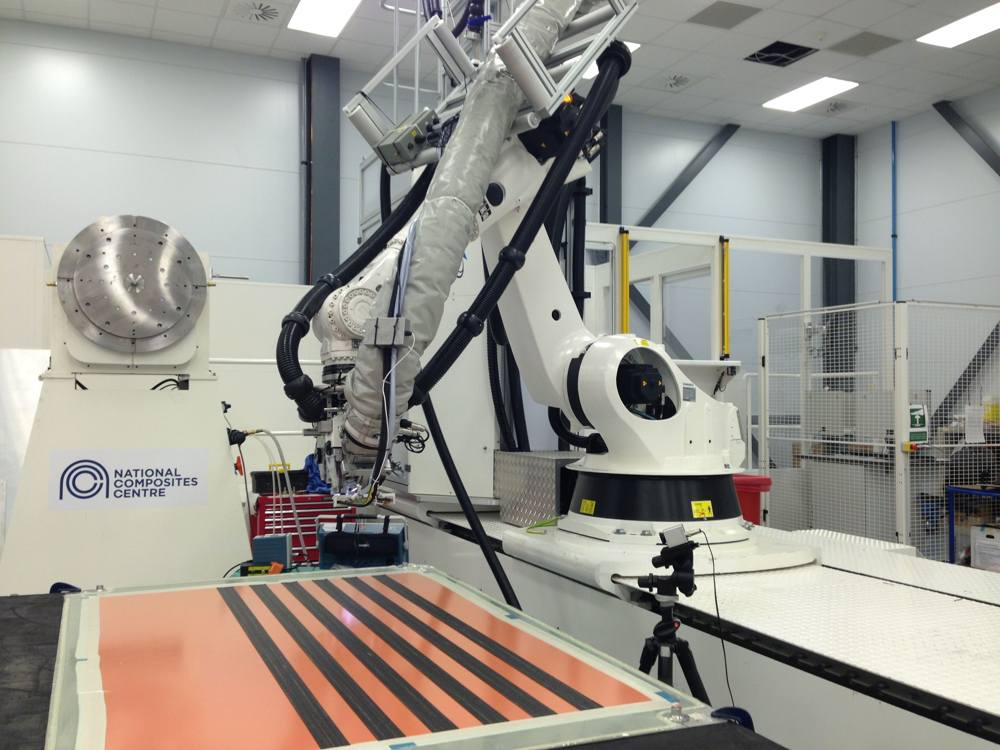A flash of inspiration!

Heraeus Noblelight has proved its Xenon flash lamp can also be used as a highly controllable source of heat, unlocking new applications in composite manufacturing. Aerospace Manufacturing reports.
For many years, Heraeus Noblelight has been known for its excellence in photonics technology, producing specialist lamps with wavelengths ranging from ultraviolet to infrared for industrial, scientific and medical applications. Based on the Cambridge Science Park, the Heraeus facility won the Queen’s Award for Innovation in 2015 for the manufacture of flashlamps – quartz glass tubes filled with high pressure Xenon gas - that are high power, broadband, pulsed energy sources. The lamps have typically been used as the pumping source within solid state lasers and as a direct light source for aesthetic applications, such as hair removal. Now innovative applications outside these areas have emerged.
Heraeus’s breakthrough innovation has been to create a system that uses the flashlamp as a direct heat source for composites manufacture. The initial development with the National Composites Centre (NCC) showed that the pulsed, broadband energy output from the Xenon lamp was remarkably well-suited to heating composite materials both quickly and controllably. The first trials measured surface temperatures that were raised from ambient to over 400°C with one 10ms duration pulse from the lamp.
The most obvious first target application for the flashlamp was Automated Fibre Placement (AFP) – an additive manufacturing process where thin tows (or ribbons) of composite material are accurately placed and adhered onto a tool by a robot with a specialised end-effector. The material is built up in layers to form the shape of a particular component. In standard aerospace applications, where the material contains carbon fibres in an epoxy matrix, the component is then cured under high temperature and pressure in an autoclave oven to produce the final part. The tows themselves have minimal surface ‘tack’ to facilitate easy passage through the AFP equipment and hence need to be heated immediately prior to placement, so that each set of tows adheres to the tool or previously placed material.
Turning up the heat

When Heraeus and the NCC first met, the NCC engineers had already established that existing AFP heating solutions were falling short of ideal performance. For example, Infrared (IR) lamps were relatively slow to heat and cool, held residual heat when switched off and were not powerful enough to heat higher temperature materials such as dry fibre or thermoplastic composites. On the other hand, diode lasers were powerful but were physically large, limiting the geometric complexity of achievable parts, and had significant health and safety issues. The conclusion was that the industry needed a fast, controllable, safe and physically small AFP heating solution. The new system being developed by Heraeus, now christened humm3, offered such a solution.
The rapid development of the humm3 technology was made possible by funding through the National Aerospace Technology Exploitation Programme (NATEP) and strong support by technology managers at the Midlands Aerospace Alliance (MAA).
Heraeus’s technical director, Jeremy Woffendin comments: “The NATEP funding was absolutely critical in developing these early ideas and prototypes into a technology demonstrator sufficiently high in technology readiness to show to industry.”
During the 18-month project with a major composites manufacturer and a key aerospace OEM, and with strong collaboration from the NCC, a full-scale system was designed and tested. The project included a comparison of the humm3 system with IR lamps and lasers, proving that the new technology is significantly faster, more powerful and more controllable than IR lamps. This meant that the high temperatures required for materials such as dry fibre (up to 200°C) and thermoplastics (up to 420°C) could be processed, at speeds up to 1m/sec. It also showed that the system is safer, smaller and more easily scalable than laser systems. As a conclusion to the NATEP project, several demonstrator days were held at the NCC showing the humm3 technology working on an industrial AFP robot system. This generated a great deal of interest from aerospace industry representatives and acted as a springboard to the subsequent development of the fully industry-ready humm3 system that exists today.
At close quarters
One of the most important benefits is that although Heraeus’s system is very powerful, operators are able to remain close to the AFP equipment while it is running. This is because Xenon lamps do not have the same health and safety requirements as a laser-based system, where operators typically have to retreat to a protective booth while lay-up is being carried out. Hence humm3 technology can provide the lay-up capabilities of a laser in a realistic production environment which permits closer interaction with operatives. Furthermore, by pulsing the Xenon lamp and controlling pulse duration, frequency and energy, it is possible to tailor the surface and through-thickness temperature profiles of the composite to suit the characteristics of the target material.

For Heraeus Noblelight, the latest developments on this breakthrough composites heating technology feels a little like completing a circle. The humm3 technology grew from initial ideas at the company’s research laboratory on the Cambridge Science Park through a strong collaboration with the NCC. As part of their wider capability development programme, the NCC has now commissioned a new multi-million-pound fibre placement machine, manufactured by Electroimpact. This machine will include fully integrated humm3 systems covering a range of heating widths from 75mm up to 200mm for AFP and up to 300mm for Automated Tape Laying (ATL). A number of aerospace OEMs will use this new placement machine to prove the industrialisation of their composites manufacturing processes.
The humm3 technology has come at an opportune time, as companies begin gearing up for the much-discussed rate increases demanded by the market. Beyond AFP manufacture, Xenon lamp technology is also revealing it’s unique heating capabilities in the areas of filament winding and thermoplastic welding, in addition to non-composites applications such as sintering of printed electronic circuits.












